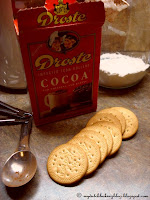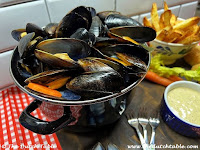During the early years, before and after the war, companies in Holland realized that one way of reaching into the tightly pinched pockets of the Dutch housewife was through the hearts (or the constant jengelen) of her children. Marketing companies invented mascots, fictitious people and fantasy figures to distinguish their company from other ones, and promoted their products in marketing materials such as booklets, cartoons, radio ads and even short movies. Especially the cartoons were very popular among the younger kids, and if you happened to own some, you could be assured of plenty of attention!
Piet Pelle was a fictitious young man who rolled into one exciting adventure after the other on his Gazelle bicycle. Flipje from the Betuwe, a fertile fruit growing region in the Netherlands, was something akin of a young man, with a human head, the body of a raspberry and limbs made out of currants. His head was adorned with a chef's hat and he would always end his adventures with a party, inviting everybody to eat copious amounts of jam, fruit juice and other fruit related products that, oh coincidence, all came from the Betuwe region. Joris Driepinter, Joe ThreePints, was the figure for the dairy industry, showing that by drinking three glasses of milk a day, you would have enough strength to even lift up a car. Okay.
Arretje Nof was another one of those concoctions of the marketing agencies. The Nederlandse Olie Fabriek (Dutch Oil Factory, or NOF) published regularly booklets about the adventures of a young Arab boy called Arretje-NOF. The cartoons could be purchased by saving coupons with points that were printed on the packaging of NOF products. Not many remember the cartoons but the one thing that, to this day, appears prominently in traditional Dutch desserts is the so-called Arretje's Cake.
Is it tasty? Most say that they love this no-bake cake. You can hardly go wrong with sugar, cookies, chocolate and butter. Try for yourself and see what you think! The original recipe calls for shortening, but margarine or even butter ("real butter" as the Dutch say) is more commonly used.
Our recipe includes raw eggs, but brings the batter up to 140F (60C) on the stove to make sure any pathogens are destroyed. Raw or undercooked eggs can be a safety risk. If you don't have a food thermometer, or want to be on the safe side, please use vanilla pudding or heavy cream as an alternative. Safety first!
Arretje's Cake
2 sticks butter (250 grm)
1 cup sugar (225 grm)
6 tablespoons cacao powder (40 grm)
2 eggs (or 1/4 cup of vanilla pudding or heavy cream)
2 oz dark chocolate
About 60 dry Maria cookies*
Melt the butter slowly in a sauce pan, until just melted, on low to medium heat. Mix the sugar and cacao in a separate bowl and set aside.
Beat the eggs well. Temper the eggs with some of the butter (pour in a little bit of the warm butter and stir into the eggs until it's incorporated) and keep adding the butter to the eggs until they're both mixed. Pour the mixture back into the sauce pan and take it back to the stove. Stir in the cocoa and sugar and keep stirring until they're blended into a thick chocolate sauce. Make sure all the sugar has dissolved. If you rub a little bit of the mixture between your thumb and index finger and it feels gritty, the sugar has not yet dissolved.
Grate the dark chocolate, or break it into small pieces and add it to the sauce pan. Keep stirring, and bring the temperature of the mixture up to 140F (60C) and keep it there, while stirring, for 3 1/2 minutes. If you are using vanilla pudding or heavy cream, you can skip this step. Just warm it up enough to melt the chocolate.
Take the sauce pan from the stove and let it cool a bit. In the meantime, add the cookies to a bag, or fold them into a clean towel, and roll your rolling pin over the cookies several times. You are looking to break the cookies into pieces no larger than a quarter.
Fold the cookies into the chocolate paste until they're all well covered. Line a cake pan with parchment paper or plastic film, spoon the mixture into the pan and flatten it with a spatula, making sure there are no air bubbles.
Cover and refrigerate for at least four hours, or overnight. Lift the cake out of the pan, and cut into thin slices. This cake is very rich!
* If you don't have Maria cookies, consider any other crisp cookie: iced oatmeal cookies, Oreos, or even Animal Crackers will work!
 |
| Flipje is sharing Betuwe goodies with his friends. Image from www.levensmiddelenkrant.nl/ |
Arretje Nof was another one of those concoctions of the marketing agencies. The Nederlandse Olie Fabriek (Dutch Oil Factory, or NOF) published regularly booklets about the adventures of a young Arab boy called Arretje-NOF. The cartoons could be purchased by saving coupons with points that were printed on the packaging of NOF products. Not many remember the cartoons but the one thing that, to this day, appears prominently in traditional Dutch desserts is the so-called Arretje's Cake.
The NOF board butchered a beautiful Italian recipe for chocolate salami, stripped it from all quality ingredients and replaced it with affordable items that were easy to find for the Dutch cook: margarine (which the NOF happened to produce in large quantities), dry cookies, sugar and cocoa powder instead of butter, luxury cookies and quality chocolate. Nevertheless, the Arretje's cake (presumably named because that's what Arretje celebrated his birthday with) became a huge success in Holland and has become one of those indelible memories of treats that grandmas make for, or with, their grandchildren.
Our recipe includes raw eggs, but brings the batter up to 140F (60C) on the stove to make sure any pathogens are destroyed. Raw or undercooked eggs can be a safety risk. If you don't have a food thermometer, or want to be on the safe side, please use vanilla pudding or heavy cream as an alternative. Safety first!
Arretje's Cake
2 sticks butter (250 grm)
1 cup sugar (225 grm)
6 tablespoons cacao powder (40 grm)
2 eggs (or 1/4 cup of vanilla pudding or heavy cream)
2 oz dark chocolate
About 60 dry Maria cookies*
Melt the butter slowly in a sauce pan, until just melted, on low to medium heat. Mix the sugar and cacao in a separate bowl and set aside.
Beat the eggs well. Temper the eggs with some of the butter (pour in a little bit of the warm butter and stir into the eggs until it's incorporated) and keep adding the butter to the eggs until they're both mixed. Pour the mixture back into the sauce pan and take it back to the stove. Stir in the cocoa and sugar and keep stirring until they're blended into a thick chocolate sauce. Make sure all the sugar has dissolved. If you rub a little bit of the mixture between your thumb and index finger and it feels gritty, the sugar has not yet dissolved.
Grate the dark chocolate, or break it into small pieces and add it to the sauce pan. Keep stirring, and bring the temperature of the mixture up to 140F (60C) and keep it there, while stirring, for 3 1/2 minutes. If you are using vanilla pudding or heavy cream, you can skip this step. Just warm it up enough to melt the chocolate.
Take the sauce pan from the stove and let it cool a bit. In the meantime, add the cookies to a bag, or fold them into a clean towel, and roll your rolling pin over the cookies several times. You are looking to break the cookies into pieces no larger than a quarter.
Fold the cookies into the chocolate paste until they're all well covered. Line a cake pan with parchment paper or plastic film, spoon the mixture into the pan and flatten it with a spatula, making sure there are no air bubbles.
Cover and refrigerate for at least four hours, or overnight. Lift the cake out of the pan, and cut into thin slices. This cake is very rich!
* If you don't have Maria cookies, consider any other crisp cookie: iced oatmeal cookies, Oreos, or even Animal Crackers will work!











